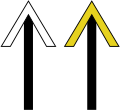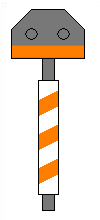|
Ne 1 - trapezoidal board
|
- Signal aspect
- A white trapeze board with a black border on a black and white diagonally striped post. The trapezoidal board stands in front of train stations without entry signals, on routes with train control it can also be set up in front of other train running points. On the main tracks there is a board below the trapezoid with an exact kilometer indication with three decimal places. It was introduced in the course of increasing safety by retrofitting point-like train control and is used to identify the location of the 2000 Hz magnet. The driver is informed of the location of the board in the command, which made it necessary to supplement the mileage.
- meaning
- Identifies the point at which certain trains have to stop in front of an operating point (usually as a delimitation of train stations ). The staff of the trains concerned will be informed of this by the timetable or a written order. As a rule, it concerns the second train to arrive at stations without local staff and with locally operated switches if a train crossing is to take place there. On main lines, the trapezoidal board serves as a replacement for non-existent entry signals on the opposite track. When driving on the opposite track with an order, trains have to stop at the level of the position of the entry signal on the control track. This signal is not necessarily visible from the opposite track, for example if there are vehicles on the control track or if both tracks are not directly next to each other.
|
|
|
Ne 2 - signal board
|
- Signal aspect
- A white board with a black border and two black angles, one above the other and touching at the top.
- meaning
- Identification of the location of a distant signal . The pre-signal board can also stand alone if, instead of a pre-signal, it indicates the braking distance of the line to a main signal, light blocking signal or a trapezoid board (in the area of the former Deutsche Reichsbahn, the cross board So 106 can also be used on branch lines). It also serves - primarily in construction sites - as an indication of a distant signal that is not located to the right of or above the track.
|
|
| Ne 2 - signal board
|
- Signal aspect
- A white board with a black border and two black angles, one above the other and touching at the top. Above it is a white triangle on its tip.
- meaning
- Identification of the location of a distant signal that is more than 5% shorter than the braking distance from the main signal .
|
|
| Ne 2 - signal board (DV)
|
- Signal aspect
- A white board with a black border and two black angles, one above the other and touching at the top. On the top of the board is a white triangle with a black dot.
- meaning
- Identification of the location of a three-aspect pre-signal (in the area of the former Deutsche Reichsbahn).
|
|
| Ne 2 - signal board (DV)
|
- Signal aspect
- A white board with a black border and two black angles, one above the other, the tips of which are covered by a white circular surface with a black border.
- meaning
- Identification of the location of a pre-signal or light pre-signal (in the area of the former Deutsche Reichsbahn) in the shorter braking distance from the main signal.
|
|
| Ne 2 - signal board (DV)
|
- Signal aspect
- A white board with a black border and two superimposed angles, the tips of which are covered by a white circular surface with a black border. On the top of the board is a white triangle with a black dot.
- meaning
- Identification of the location of a three-aspect pre-signal, which is in the shortened braking distance from the main signal (in the area of the former Deutsche Reichsbahn).
|
|
|
Ne 3 - distant beacons
|
- Signal aspect
- A tall rectangular white board with one or more black stripes rising to the right. The number of strips decreases in the direction of travel. As a rule, there are three, in exceptional cases fewer or up to five beacons in front of the distant signal. If space is limited, low rectangular or square beacons can be used. With the same number and arrangement as the black stripes, the panels can also have reflective white stripes.
- meaning
- A distant signal is to be expected.
|
|
|
Ne 4 - chess board
|
- Signal aspect
- A tall rectangular (if space is limited, square or low rectangular), black and white chessboard pattern.
- meaning
- Contrary to the rule, the main signal is at a different location. (As a rule, the main signal is to the right of the track, above the track or to the left of the opposite track.) The chessboard is at the actual location of the main signal.
|
|
|
Ne 5 - holding board
|
- Signal aspect
- A black board with a white H or a white board with a black border and a black H.
- meaning
- Marking of the stopping place of the Zugspitze when trains stop as scheduled. In the version of an H that shines with a white flashing light - stop at the required stopping point within the braking distance. (DB Station & Service has been offering an "orientation sign on the platform" since 2017 for stations without a stop sign.)
|
|
|
Ne 6 - stopping point board
|
- Signal aspect
- A rectangular horizontal board with three black diagonal stripes.
- meaning
- A breakpoint is to be expected. The signal is at a 45 degree angle to the track.
|
|
|
Ne 7 - snow plow board (a)
|
- Signal aspect
- A white or yellow upward-pointing arrowhead with a black border.
- meaning
- Raise ploughshare.
|
|
| Ne 7 - snow plow board (b)
|
- Signal aspect
- A white or yellow downward pointing arrowhead with a black border.
- meaning
- Lower the ploughshare.
|
|
|
Ne 12 - announcement beacon
|
- Signal aspect
- An orange rectangular board with two white stripes.
- meaning
- Observe the monitoring signal of a fallback switch (Ne 13)!
|
|
|
Ne 13a - monitoring signal of a fallback switch
|
- Signal aspect
- A white light over an orange horizontal stripe with an orange and white striped mast sign.
- meaning
- Fallback switch is passable towards the top.
|
|
|
Ne 13b - monitoring signal of a fallback switch
|
- Signal aspect
- A horizontal orange stripe with an orange and white striped mast sign.
- meaning
- The fall-back switch cannot be driven towards the tip, you must stop in front of the switch.
|
|
|
Ne 14 - ETCS-Halttafel (English also called Stop Marker or Marker Board )
|
- Signal aspect
- A yellow arrow with a white border on a blue square board. The arrow points in the direction of the track to which it applies and can point to the left, right or down.
- history
- The signal was introduced with temporary validity by decision of the Federal Railway Authority on June 14, 2011. The signal is attached to the masts of entry, exit and intermediate signals that cover points. On routes with ETCS Level 2 without signals, the ETCS stop panels are only in the places where the signals mentioned would otherwise be. Then they are supplemented with the signal labels for the non-existent signals.
- meaning
- Stop for trains in ETCS mode SR (Staff Responsible).
|
|
|
So 1 - end table (DV)
|
- Signal aspect
- A square red plaque with a white cross on top.
- meaning
- Stop driving on sight. The board is only used on the Berlin S-Bahn. It stands behind route branches if one of a route with an automatic route block branches off without it and the exit signal is provided with a red mast sign .
|
|
|
Sun 19 - main beacons (DV)
|
- Signal aspect
- Three consecutive square orange-colored panels with white circular areas, the number of which decreases in the direction of travel.
- meaning
- A main signal is to be expected (only in the area of the former Deutsche Reichsbahn).
|
|
|
So 20 - assignment table (DV), (in the DS area without short description)
|
- Signal aspect
- A black rectangle with a white triangle pointing left or right.
- meaning
- The signal marked by the allocation table applies to the track to which the tip of the triangle points.
|
|
|
So 106 - Kreuztafel (DV)
|
- Signal aspect
- A white hexagonal plaque with a black, lying cross on a black and white diagonally striped post.
- meaning
- If a distant signal is missing, the cross board indicates that a main signal is to be expected. This signal is only available on branch lines. At the former Deutsche Bundesbahn (DB), the cross board was abolished in 1959 and a warning board was set up instead.
|
|















